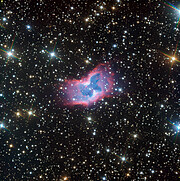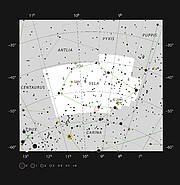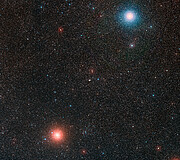Pressmeddelande
Himmelsk fjäril fångad med ESO-teleskop
30 juli 2020, Skurup
Den symmetriska och färggranna planetariska nebulosan NGC 2899 verkar likt en fjäril fladdra fram över den stjärnbeströdda himlen i denna nya bild tagen med ESO:s Very Large Telescope (VLT). Objektet har aldrig tidigare skådats i sådan detaljrikedom.
Gasen i denna vackra planetariska nebulosa [1], med gastemperaturer som närmar sig 10 000 grader, sträcker sig så långt som två ljusår från centralstjärnan. Nebulosans höga temperatur orsakas av stjärnans intensiva strålning som får vätgasen att lysa rött, medan syret i gasen lyser blått.
Objektet befinner sig någonstans mellan 3000 och 6500 ljusår bort i stjärnbilden Seglet på södra stjärnhimlen. I nebulosans mitt befinner sig två stjärnor mycket nära varandra, vilket tros vara orsaken till nebulosans symmetriska utseende. En av stjärnorna har nått slutet av sitt liv och kastat ut sina yttre atmosfärslager i rymden, medan den andra stjärnan stör gasens rörelser och får den att forma sig i ett välordnat mönster. Mellan 10 och 20 procent av alla planetariska nebulosor uppvisar detta dubbellobade utseende.
Astronomerna tog denna bild med FORS-instrumentet på Antu, ett av huvudteleskopen (UT1) som ingår i VLT. FORS (FOcal Reducer and low dispersion Spectrograph) är ett av de första instrumenten som installerades på VLT och har bidragit med observationer av en mängd olika objekt som gravitationsvågskällor, interstellära småplaneter och djupstudier av komplexa planetariska nebulosor.
Denna bild togs som en del av ESO:s Cosmic Gems Programme, ett projekt för att avbilda intressanta, spännande eller visuellt anslående objekt med ESO:s teleskop, i syfte att användas för utbildning och utåtriktad verksamhet. Projektet utnyttjar teleskoptid som inte kan användas för vetenskapliga observationer, men den data som samlas in görs ändå tillgänglig för astronomer via ESO:s vetenskapliga arkiv.
Noter
[1] Trots namnet har planetariska nebulosor inget med planeter att göra. När de första nebulosorna upptäcktes beskrevs de som planetlika i teleskopet. De bildas när gamla stjärnor med upp till 6 gånger solens massa når slutet av sina liv blir instabila och kastar ut sina yttre atmosfärslager i rymden, berikade på tunga grundämnen. Energirik ultraviolett strålning från centralstjärnan får den utkastade gasen att sända ut ljus under tusentals år, tills den slutligen förtunnas och sprids ut i rymden mellan stjärnorna. Planetariska nebulosor är därför i ett astronomiskt perspektiv relativt kortlivade objekt.
Mer information
ESO är Europas främsta mellanstatliga samarbetsorgan för astronomisk forskning och med råge världens mest produktiva astronomiska observatorium. Det har 16 medlemsländer: Belgien, Danmark, Finland, Frankrike, Irland, Italien, Nederländerna, Polen, Portugal, Schweiz, Spanien, Storbritannien, Sverige, Tjeckien, Tyskland och Österrike. ESO:s ambitiösa verksamhet rör design, konstruktion och drift av avancerade markbaserade forskningsanläggningar som gör det möjligt för astronomer att göra banbrytande vetenskapliga upptäckter. ESO spelar dessutom en ledande roll i att främja och organisera samarbeten inom astronomisk forskning. ESO driver tre unika observationsplatser i Chile: La Silla, Paranal och Chajnantor. Vid Paranal finns Very Large Telescope, världens mest avancerade observatorium för synligt ljus, och två kartläggningsteleskop. VISTA arbetar i infrarött ljus och är världens största kartläggningsteleskop och VST (VLT Survey Telescope) är det största teleskopet som konstruerats enbart för att kartlägga himlavalvet i synligt ljus. ESO är en huvudpartner i ALMA, världens hittills största astronomiska projekt. Och på Cerro Armazones, nära Paranal, bygger ESO det extremt stora 39-metersteleskopet för synligt och infrarött ljus, ELT. Det kommer att bli ”världens största öga mot himlen”.
Länkar
Kontakter
Johan Warell
Astronom och ESON-representant för Sverige
Skurup, Sverige
Tel: 0706-494731
E-post: eson-sweden@eso.org
Bárbara Ferreira
ESO Public Information Officer
Garching bei München, Germany
Tel: +49 89 3200 6670
Mobil: +49 151 241 664 00
E-post: pio@eso.org
Om pressmeddelandet
| Pressmeddelande nr: | eso2012sv |
| Namn: | NGC 2899 |
| Facility: | Very Large Telescope |
| Instruments: | FORS2 |





